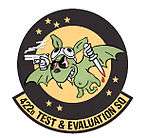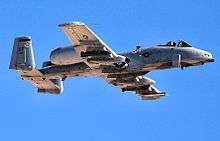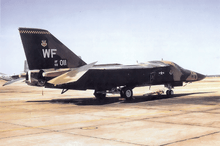422d Test and Evaluation Squadron
| 422d Test and Evaluation Squadron | |
|---|---|
 Lockheed Martin F-35A Lightning II 10-5020  Lockheed Martin F-22A Block 30 Raptor 06-4124 | |
| Active | 1943-1945; 1969-Presnt |
| Country |
|
| Branch |
|
| Type | Squadron |
| Role | Operational Testing |
| Part of | 53d Test and Evaluation Group |
| Garrison/HQ | Nellis Air Force Base, Nevada |
| Engagements |
|
| Decorations |
|
| Insignia | |
| Emblem of the 422d Test and Evaluation Squadron |
 |
The 422d Test and Evaluation Squadron (422 TES) is a United States Air Force unit. It is assigned to the 53d Test and Evaluation Group, stationed at Nellis Air Force Base, Nevada. The squadron performs operational testing of all fighter aircraft and munitions entering and in operational use by Air Combat Command (ACC).
The unit was originally formed as the 422d Night Fighter Squadron in 1943. After training in the United States, it was deployed to Ninth Air Force in England in the spring of 1944, prior to the D-Day landings in France. During the run-up to D-Day, the squadron trained with Royal Air Force night fighter units against Luftwaffe raiders who intruded the night skies over England. It was the first American squadron in England equipped with the Northrop P-61 Black Widow night fighter. After the landings in France, the mission of the squadron became the air defense of Allied liberated territory. During the Battle of the Bulge, it also flew day and night interdiction missions against enemy troop movements, bridges and other targets of opportunity. It was inactivated shortly after the war in Europe ended.
In 1969, the squadron was re-activated at Nellis Air Force Base by Tactical Air Command to provide combat evaluation and operational testing of new USAF aircraft entering the inventory after developmental testing was completed at Edwards AFB.
Overview
The 422d Test and Evaluation Squadron is a Geographically Separated Unit (GSU) of the 53d Test and Evaluation Group, home stationed at Eglin AFB, Florida. It is the most diverse-equipped aircraft squadron in the United States Air Force.[1]
After a new fighter weapons system completes Developmental Testing (DT) at either Edwards AFB, California, or at Eglin AFB, Florida, the mission of the 422d TES to thoroughly vet the new equipment in a combat representative environment. This task is essential, as the lives of pilots and other aircrew will depend upon the performance of any new system during actual combat operations.[1]
The 422d TES is a composite squadron that currently includes A/OA-10, F-15C, F-15E, F-16CM, F-22 and the F-35. Testing and evaluation includes the aircraft hardware, engines, software, and weapons upgrades prior to release of the aircraft or modification to operational Air Combat Command operational units.[1]
In addition to its operational testing mission, the 422d TES is also responsible for the development and testing of new tactics for the USAF. The squadron develops new tactics to employ weapons systems in combat as part of its operational testing role. Additionally, the unit also works on developing new tactics to counter emerging threat weapons systems as intelligence becomes available. [1]
When developing new tactics, the 422nd TES works closely with the USAF Weapons School. However, ultimately, the 422d TES is responsible for the development and testing of all new tactics for every CAF fighter Mission Design Series (MDS). The squadron supports other mission areas, to include foreign materiel exploitation and field visits to instruct operational aircrews on new systems and tactics. [1]
Current Divisions
- A-10 Division
- Established 1977. Conducts a special evaluation of night vision modified cockpits to determine optimum compatibility with night combat operations. They also examined night medium altitude operations to determine the best suited tactics to expand the A-10's night Close Air Support capabilities. In 1997 the A-10 Division conducted an extensive evaluation of close air support tactics for use in urban war zones.[2]


- F-15 Division
- Established 1977 as F-15A Division, F-16C in 1982. Division was at the forefront of night air superiority as they evaluated night composite force tactics. They also developed and evaluated Night Vision Goggle tactics for the F-15C Eagle, a first for this aircraft in the active Air Force.[2]
- F-15E Division
- Established 1989. Developed new methods of employing the LANTIRN system in a counter-offensive air-to-air role. The F-15E division aircrews also became the first in the Air Force to employ Night Vision Goggles, as they developed and evaluated new tactics in night combat search and rescue.[2]
- F-16 Division
- Established 1980 as F-16A Division, F-16C in 1985. Evaluated Night Vision Goggle (NVG) employment in several missions, including night combat search and rescue, along with various NVG compatible cockpit configurations. In January 1997 422 TES F-16 pilots evaluated and dropped the first live Joint Direct Attack Munition.[2]
- F-22 Division
- Established 2004 for testing and evaluation of the F-22A Raptor.[2]
- F-35 Division
- Established September 2013 for testing and evaluation of the F-35A Lightning II.[2]
Aircraft tail code initially was "WF" upon formation of the squadron in 1969. Recoded to "WA" in October 1971 with yellow/black checkerboard tail stripe. Recoded 1 October 1996 to "OT" tail code, with a green/black checkerboard tail flash.[3]
History
World War II

The squadron was established on 1 August 1943 as the 422d Night Fighter Squadron at Orlando AAB, Florida. The 422d was the first of the third group of dedicated night fighter squadrons trained by the Army Air Forces It initially trained with the Douglas P-70 Havoc night fighter at Orlando, although later that fall the squadron began to train with the Northrup YP-61 Black Widow. In January, training was interrupted when the night fighter school was moved from Florida to Hammer Army Airfield, California. After the relocation, the squadron completed its training in March 1944[4]
The 422d was the first night fighter squadron to be assigned to Ninth Air Force in England. Charmy Down eventually would become the home of three night fighter squadrons (422d, 423d, and 424th), however the squadron arrived un-equipped as the P-61 Black Widows were late in arriving. Subsequently, the squadron had its aircrews posted to various RAF night fighter and signal schools for theatre indoctrination. Meanwhile, as there was no sign of the P-61s. the pilots kept up their flight time on Cessna UC-78s and de Havilland Mosquitoes.[4]

The squadron was moved to RAF Scorton on 6 May. The original plan had been for all three night fighter squadrons to be on combat status with P-61s by D-Day, however the first P-61 didn't arrive until the end of May, about two weeks before the planned D-Day invasion of France. With the arrival of the German V-1 Flying Bombs over England after the invasion, the squadron trained with their Black Widows by intercepting the flying bombs. The first Black Widow V-1 "kill" took place on 16 July 1944, credited to pilot Herman Ernst and radar operator Edward Kopsel of the 422nd Night Fighter Squadron. One of the greatest dangers involved in killing V-1s was the possibility of getting too close to the flying bomb when one fired at it, running the risk of damage to their own plane if the bomb exploded when hit.[4]
Finally, on 25 July, a month and a half after D-Day, the squadron was considered to be operationally ready for night interception and moved up to Maupertu Airfield (A-15) in France. From Maupertu the squadron entered combat and began to perform night interception of ntruding Luftwaffe bombers and night fighters. As the number of enemy night intruders was small, the squadron also performed offensive interdictionary attacks on Axis forces in France and the Low Countries, 1944, moving eastward through a series of Advanced Landing Grounds until operating from captured Luftwaffe bases in Germany during the spring of 1945.[4]
The squadron ended combat operations in May 1945 and became part of the Army of Occupation until August 1945. Demobilized in Europe, aircraft flown back to the United States for storage or use with postwar All Weather Air Defense Command interceptor squadrons.[4]
Weapons testing
The unit was reactivated in 1969 as the 422d Test and Evaluation Squadron when the 4539th Fighter Weapons Squadron became the 422d Fighter Weapons Squadron at Nellis Air Force Base, Nevada.[5]

Its initial primary mission was the operational test and evaluation of F-111 aircraft. Took over F-111As of 4539th Combat Crew Training Squadron, aircraft tail coded "WF". In 1977, F-111 testing ended at Nellis AFB and was relocated to McClellan Air Force Base, California, as Detachment 3, 57th FWW. McClellan was the Air Force Logistics Command prime support depot for the F-111 and changes and modifications could be made there and tested by the detachment. The 431st TES was activated at McClellan in 1980, replacing the detachment and remained active until June 1992 when the F-111D was retired.[5]
In 1971 the F-4 joined the squadron; A-7D's were added in 1972, and were flown until 1975. A-10 and F-15 aircraft were added in 1977, as were F-16A’s in 1980. In 1982 the 422 Fighter Weapons Squadron's name changed to the 422d Test and Evaluation Squadron (TES), to better reflect its role.[5]
In 1985, the F-4E was retired from the 422 TES. During this time, the F-16C began testing at Luke Air Force Base, Arizona, as the 57 Fighter Weapons Wing, Det 1. In October, 1987, F-16C Det 1 was closed at Luke, and its aircraft were moved to Nellis AFB. This gave the 422 TES an aircraft complement of A-10s, F-15s, F-16As, and F-16Cs.[5]
1989 saw the rapid expansion of squadron capability with the addition of the F-15E and F-16C Low Altitude Navigation Targeting Infrared Night (LANTIRN) aircraft. With these two systems, the 422 TES greatly expanded its ability to fly night tactical missions.[5]

1991 began with Operation DESERT STORM. Although the 422 TES did not deploy for direct participation, it was involved in several quick look evaluations of equipment and employment tactics which directly enhanced the effectiveness of the air war. The outstanding efforts of the 422 TES over the past ten years to improve weapons, avionics, and tactics provided the ultimate reward: a quick and decisive victory.[5]
The 422 TES began 1993 with the return of a veteran aircraft to the line-up. The F-4G Wild Weasel officially became part of the testing program at Nellis AFB on 1 February 1993. The HH-60 Blackhawk helicopter came aboard on 1 July 1995 as the newest member of the 422 TES team. Later that year the F-4 was retired again, as the last test F-4G was flown to the Aerospace Maintenance Regeneration Center in Arizona.[5]
On October 1, 1996, the 422 TES was re-aligned under the 53d Wing, Eglin AFB, Florida, as the Air Warfare Center assigned all testing to this wing. The squadron grew to its largest size since World War II when the squadron inherited all test management, advanced programs, and test support from the 57th Test Group.[5]
The mission of the 422d Test and Evaluation Squadron continues to grow in scope and complexity as new aircraft and systems are developed for use in the combat air forces. Recent testing by the 422d Test and Evaluation Squadron has been focused on enhancing mission employment capabilities at night[5]
Lineage
- Constituted as 422d Night Fighter Squadron on 14 July 1943
- Activated on 1 August 1943
- (Not manned after 26 May 1945)
- Inactivated on 30 September 1945
- Re-designated as 422d Fighter Weapons Squadron on 22 August 1969
- Activated on 15 October 1969.
- Re-designated 422d Test and Evaluation Squadron on 30 December 1981[6]
Assignments
- Air Defense Department, Army Air Forces School of Applied Tactics, 1 August 1943
- 481st Night Fighter Operational Training Group, 29 October 1943
- AAF Tactical Center, 6 January 1944
- IX Fighter Command, 7 March 1944
- IX Tactical Air Command, 12 March 1944
- 71st Fighter Wing, 4 May 1944
- IX Air Defense Command, 6 August 1944
- IX Tactical Air Command, 7 October 1944 – 30 September 1945
- 57th Fighter Weapons (later, 57th Tactical Training; 57th Fighter Weapons; 57th Fighter) Wing, 15 October 1969
- 57th Test Group, 1 November 1991
- 79th Test and Evaluation Group, 1 August 1997
- 53d Test and Evaluation Group, 20 November 1998 – Present[6]
Components
|
|
Stations
|
|
Aircraft
World War II
|
|
United States Air Force
|
|
See also
| Wikimedia Commons has media related to 422d Night Fighter Squadron. |
| Wikimedia Commons has media related to 422d Test and Evaluation Squadron. |
References
![]() This article incorporates public domain material from the Air Force Historical Research Agency website http://www.afhra.af.mil/.
This article incorporates public domain material from the Air Force Historical Research Agency website http://www.afhra.af.mil/.
- 1 2 3 4 5 The 422nd Test and Evaluation Squadron: The cutting edge of airpower
- 1 2 3 4 5 6 Nellis AFB units
- ↑ Martin, Patrick. Tail Code: The Complete History of USAF Tactical Aircraft Tail Code Markings. Schiffer Military Aviation History, 1994. ISBN 0-88740-513-4.
- 1 2 3 4 5 Northrop P-61 Black Widow—The Complete History and Combat Record, Garry R. Pape, John M. Campbell and Donna Campbell, Motorbooks International, 1991.
- 1 2 3 4 5 6 7 8 9 History of the 422d Test and Evaluation Squadron, compiled by the 96th Test Wing Public Affairs, Eglin Air Force Base, FL
- 1 2 3 4 5 6 AFHRA 422d Test and Evaluation Squadron Lineage and History
- Maurer, Maurer, ed. (1983) [1961]. Air Force Combat Units of World War II (PDF) (reprint ed.). Washington, DC: Office of Air Force History. ISBN 0-912799-02-1. LCCN 61060979.
- Maurer, Maurer, ed. (1982) [1969]. Combat Squadrons of the Air Force, World War II (PDF) (reprint ed.). Washington, DC: Office of Air Force History. ISBN 0-405-12194-6. LCCN 70605402. OCLC 72556.


.svg.png)